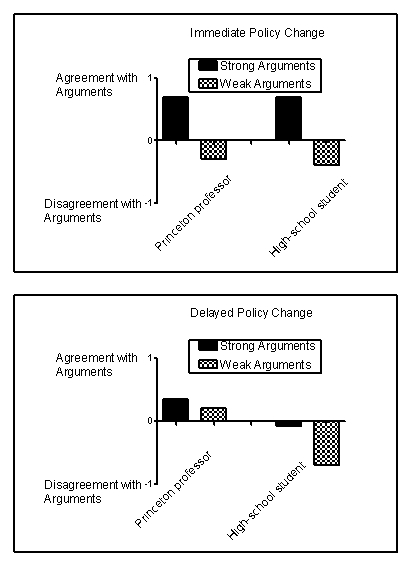Scenario II
The following scenario contains fabricated results consistent with the following study:
Petty, R. E., Cacioppo, J. T., & Goldman, R. (1981) . Personal involvement as a determinant of argument-based persuasion. Journal of Personality and Social Psychology, 41, 847-855.
Every day, consumers are exposed to scientifically based sales, marketing, and public relations strategies designed to influence purchasing decisions, change opinions, or win votes. One common sales strategy is the foot-in-the-door technique, a method that involves first making a smaller request that consumers are likely to grant and then following it by a larger request. Another common strategy is the door-in-the-face technique, which involves making an unreasonably large request that consumers will reject and then following it by a smaller request. When persuasion is necessary, it usually takes one of two forms: heuristic persuasion involves an appeal to habits or emotion, and systematic persuasion involves an appeal to facts and reason. Often, people will rely more on heuristics-simple short-cuts or "rules of thumb"-to make decisions instead of systematically weighing the evidence.
Petty and colleagues (1981) investigated some of these techniques in college students listening to arguments in favor of their college requiring an institution-level comprehensive final examination for graduation. Some students were led to believe that, if adopted, this policy would take place right away, and some were led to believe that the change would take place in a decade. In addition, some of the students were led to believe that they were listening to an argument from a Princeton professor, and others were led to believe that they were listening to an argument from a high-school student. Finally, some students heard strong arguments in favor of the policy, and some heard weak arguments. Thus, the experiment arranged six groups of students. For example, one group of students heard strong arguments from a high-school student about a far-removed policy change. Figure 13.1 shows fabricated results illustrating the major findings of this experiment.
Figure 13.1 
-(Scenario II) In the Petty et al. (1981) experiment, the purpose of manipulating the time that the policy would go into effect was to:
Definitions:
Normally Sighted
Having vision within the range considered typical or normal, without significant visual impairment.
Smiling
A facial expression formed by flexing the muscles at the sides of the mouth, often signifying joy, amusement, or sociability.
Blind Group
A control group in an experiment that is not exposed to the treatment or intervention being tested, ensuring that the effect of the variable being studied can be accurately measured.
Social Smile
An infant's spontaneous smile, often occurring from birth and becoming socially responsive between 6 to 8 weeks of age.
Q2: Which component of the mind did Freud
Q22: Attractive people tend to have better social
Q53: Which statement BEST describes the effects of
Q67: Heuristic persuasion loses some of its power
Q67: Recent research suggests that men and women
Q85: If another person challenges our self-concept, we
Q95: All of these are aspects of personality
Q109: Approximately _ as many boys than girls
Q135: The primary reason that Southern men are
Q189: Allport believed that traits are preexisting dispositions